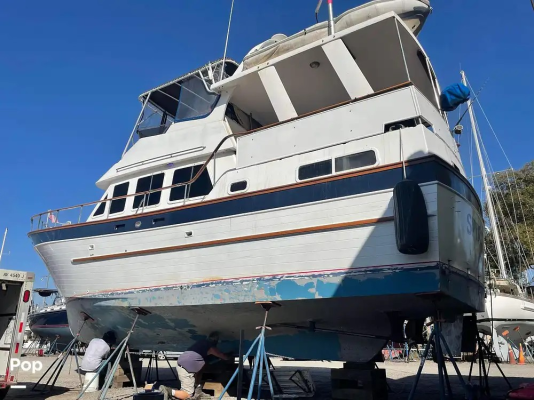Living is south florida, i'm always on the lookout for hurricane holes. Particularly hurricane holes where i do not have to worry about other boats dragging into me.
I got my eyes on a spot in the mangroves so obscure and out of the way that I expect I would be the only soul there. Problem is i scouted it with my skiff depth finder and at low tide it is only 2-3ft. Our tides are usually about 2ft.
I've heard old salts on sailboats talking about burying their keels in the mud for storms. I'm wondering if that would be ok for my boat or if it would be too much pressure on my shafts/rudders? I have a 4ft draft twin screw Marine Trader 44 cpmy, which is essentially the 40 in the photo (but with a 4ft cockpit).
I need to go back to the spot with a boat pole and see if the mud is that real loose/soft/silty quicksand material that is often back in those holes, or if it's more of a medium density mud.
I am on the east coast -- not sure if we get those extreme negative tides from hurricanes like are common on the west coast? Considering the location is an oxbox on a tidal creek, I would generally expect higher tides during storm, but want to consider the possibility of a negative tide anomally. Regardless, i would have to get back there before the storm, so I'm guaranteed to be sitting 2 ft in the mud at low tide at least for a few cycles.
What are your opinions -- specifically about sitting in the mud?
I got my eyes on a spot in the mangroves so obscure and out of the way that I expect I would be the only soul there. Problem is i scouted it with my skiff depth finder and at low tide it is only 2-3ft. Our tides are usually about 2ft.
I've heard old salts on sailboats talking about burying their keels in the mud for storms. I'm wondering if that would be ok for my boat or if it would be too much pressure on my shafts/rudders? I have a 4ft draft twin screw Marine Trader 44 cpmy, which is essentially the 40 in the photo (but with a 4ft cockpit).
I need to go back to the spot with a boat pole and see if the mud is that real loose/soft/silty quicksand material that is often back in those holes, or if it's more of a medium density mud.
I am on the east coast -- not sure if we get those extreme negative tides from hurricanes like are common on the west coast? Considering the location is an oxbox on a tidal creek, I would generally expect higher tides during storm, but want to consider the possibility of a negative tide anomally. Regardless, i would have to get back there before the storm, so I'm guaranteed to be sitting 2 ft in the mud at low tide at least for a few cycles.
What are your opinions -- specifically about sitting in the mud?
Attachments
Last edited:

